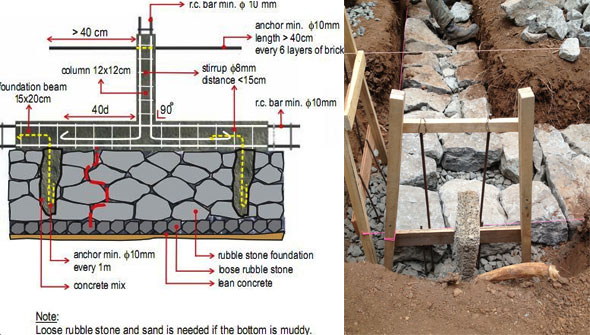Types and Benefits of Stone Foundation
- Concrete Cost Estimator
- Concrete Continuous Footing
- Landscape Bidding and Estimating
- Construction Cost Estimating
- Concrete and steel cost estimation
- Construction Cost Estimate Breakdown
- Construction Estimating Worksheet
- Home Construction Cost Estimate
- Estimate Pricing Sheet
- Sheet for General Contractor
- Construction Cost Estimate
- Labor Materials Cost Estimator
- Masonry Estimating Sheet
- Sheet for Building Contractor
- Construction Schedule Bar chart
- General Cost Estimator Sheet
- General Construction Estimate
- Building and Road Estimating Sheet
- Detailed expense estimates
- Door and Window Takeoff Sheet
- General Construction Cost Estimating Sheet

A foundation stands for the structure that develops a robust level base upon which a building is constructed. The construction process of foundation should be perfect with proper leveling to get rid of different types of issues like settlement issues, wall cracking, bowing, water penetration and a host of other issues.
Natural stone is gaining popularity in construction sectors due to greater compressive strength, extraordinary strength and local accessibility.
General construction method of stone foundation:
Two walls (or wythes) of stone with 8 inches thickness are constructed facing opposite directions maintaining a 4-inch gap in between. By using a liquid lime-based mortar, this space is filled with and the stone wythes are pointed up and sealed. Similar stone and local limestone are generally used for this purpose.
Based on the structure and the mason, the following types of stonework are utilized :-
Fully Pitched Scotch Bond: In this type of stonework, all stones are mostly squared and contain the faces pitched. It makes the “breasted” look and forms a straighter building line. The mason arranges each stone cautiously at various angles and a series of rules is followed while setting up the pattern.
Roughly Squared Scotch Bond: It refers to a medium grade of stonework. The stones are squared and contain a relaxed tolerance. Some stones are attached at matching angles, if convenient. The faces of the stones are pitched only in case of placing the stones in the wall line to avoid breasting.
Random Rubble: It belongs to the lowest grade of stonework, but also an art form if the method is accurate. This pattern involved simply using whatever stone was provided on the top of the pile and setting it where it can be accommodated. Corners are constructed with the largest and most square stones.
Also Read: Some useful guidelines on the construction of RCC foundation
The very little cutting is performed by hand with a stone hammer to simply knock off a chunk to accommodate a piece perfectly. Random rubble is normally created with materials available on the site.
Benefits of Stone Foundations:
1. Water penetration: A stone foundation has good water resistance capacity. It’s very thick (20″+) and as a result when the small amounts of water enter into the cracks simply get immersed by the mass masonry and safely vaporized outwards. While spraying a hose, or dumping a jug of water on a stone foundation, the water astonishingly evaporates. The grouted centre of the wall is generally bone dry and crumbly, and it facilitates soaking up the water as it infiltrates the stone. The water then disappears naturally.
2. Compressive strength: Natural stone contains greater compressive strengths of all building materials. As the stone is created in layers which built up over millions of years and squeezed mutually with climate changes, like heat and pressure, the final product is solidly compressed. It is necessary to pile up stone blocks 4 kilometres high before the block on the bottom got crushed! So, it is ideal for building foundations.
3. Stability: Among all the masonry products (brick, concrete, block, man-made products, etc.) natural stone is considered as mostly long-lasting. Both the bricks and concrete are decayed with water infiltration; bricks should not be arranged below grade and are normally hollow on the inside; concrete always pits and cracks and can't be repaired easily. On the contrary, the stone is free from these issues.

- Application of concrete calculator
- Roofing Calculator can streamline the roof estimating process
- House construction cost calculator
- Engineering column design excel spreadsheet
- Material Estimating Sheet with Excel
- Materials List and Cost Estimate Worksheet
- Concrete Slab Estimating Calculator Sheet
- Common types of foundations for buildings
- Online calculation of construction materials
- Estimating with Excel for the Small Contractor
- Concrete Beam Design Spreadsheet
- Virtual Construction Management app for construction
- Autodesk’s Project Skyscraper
- Reed Construction’s Reed Insight
- Manage your construction project documentation
- Costimator, the popular cost estimating software
- On Center Software for construction professionals
- Free Construction Estimating Software
- Plumbing Calc Pro
- Cost Estimate Worksheet
- HVAC Piping Quantity Takeoff Worksheet
- Construction Estimating Software Sheet
- Estimate Cost Templates
- Construction Punch List
- Construction cost estimating template consisting estimating basic
- Gantt Chart Template for Excel
- Download Civil Engineering Spreadsheets with Verification
- The Building Advisor Estimating and Budgeting Worksheet
- Spreadsheet for design of concrete bridge
- Construction Estimating Software Free








